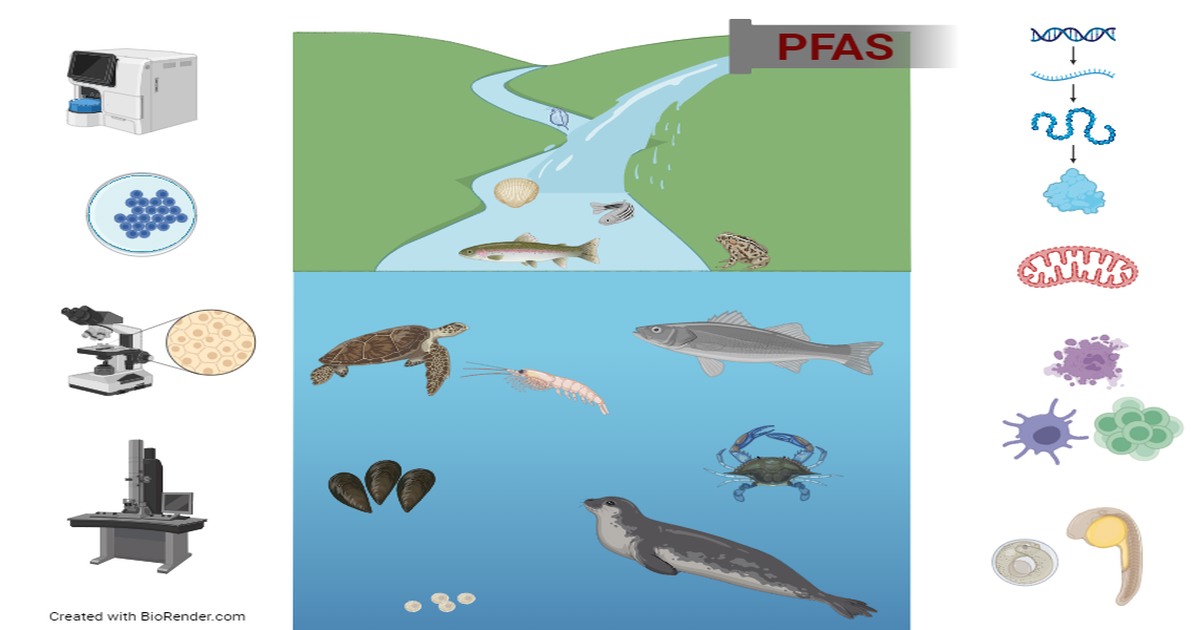Impact of Per- and Polyfluoroalkyl Substances (PFAS) on Aquatic Animals: Immunotoxicity, Endocrine Disruption, and Beyond
A special issue of Toxics (ISSN 2305-6304). This special issue belongs to the section "Ecotoxicology".
Deadline for manuscript submissions: 20 June 2025 | Viewed by 5327

Special Issue Editors
Interests: toxicologic pathology; environmental pathology; experimental pathology; cellular pathology; ultrastructural pathology; fish pathology; histopathological biomarkers; ultrastructural biomarkers; histopathological image analysis
Special Issues, Collections and Topics in MDPI journals
Interests: aquatic ecotoxicology; emerging contaminants; fish health and diseases; fish histopathology and immunology; histological biomarkers; environmental parasitology
Special Issues, Collections and Topics in MDPI journals
Special Issue Information
Dear Colleagues,
Contaminants of emerging concern (CECs) are a focal point in toxicology and environmental sciences due to their profound implications for ecosystems, wildlife, and human health. Among CECs, per- and polyfluoroalkyl substances (PFAS) are particularly worrisome in aquatic environments, where they are ubiquitous, with concentrations ranging from undetectable levels to micrograms per liter, and often persistent.
Aquatic fauna consistently face PFAS exposure, potentially serving as a pathway for human contamination through the food chain. Moreover, these animals offer valuable insights into PFAS toxicology, environmental pathology, and the One Health approach. Literature data on PFAS effects have increased greatly in the last 10 years but sometimes provide conflicting indications and still leave knowledge gaps on the exact mechanisms of toxicity, the response of organisms to environmentally relevant concentrations, and the risk posed by the new generation PFAS, which are poorly investigated.
The principal objective of the Special Issue is to advance our comprehension of the health consequences of PFAS contamination in aquatic environments, especially the effects of PFAS on the immune and endocrine systems, which play a pivotal role in enabling aquatic animals to cope with environmental stressors and, ultimately, determine their overall health and fitness. This perspective offers a distinctive exploration of the intricate interplay between these systems and others, shedding light on critical aspects of ecological and individual well-being.
This Special Issue aims to ignite comprehensive discussions on the impact of PFAS on aquatic animals, with a specific focus on immunotoxicity and endocrine disruption, and to consider the wider implications of these effects on interconnected biological systems based on a multidisciplinary approach spanning toxicology, pathology, and omic disciplines.
We expect this Special Issue will be of significant interest to researchers and professionals in the fields of toxicology, ecotoxicology, environmental sciences, and public health as it addresses an urgent matter of concern with extensive repercussions for both the natural world and human well-being.
New research papers, based on natural or experimental exposure to PFAS, as well as reviews, are welcome for this Special Issue.
Prof. Dr. Maurizio Manera
Dr. Luisa Giari
Guest Editors
Manuscript Submission Information
Manuscripts should be submitted online at www.mdpi.com by registering and logging in to this website. Once you are registered, click here to go to the submission form. Manuscripts can be submitted until the deadline. All submissions that pass pre-check are peer-reviewed. Accepted papers will be published continuously in the journal (as soon as accepted) and will be listed together on the special issue website. Research articles, review articles as well as short communications are invited. For planned papers, a title and short abstract (about 100 words) can be sent to the Editorial Office for announcement on this website.
Submitted manuscripts should not have been published previously, nor be under consideration for publication elsewhere (except conference proceedings papers). All manuscripts are thoroughly refereed through a single-blind peer-review process. A guide for authors and other relevant information for submission of manuscripts is available on the Instructions for Authors page. Toxics is an international peer-reviewed open access monthly journal published by MDPI.
Please visit the Instructions for Authors page before submitting a manuscript. The Article Processing Charge (APC) for publication in this open access journal is 2600 CHF (Swiss Francs). Submitted papers should be well formatted and use good English. Authors may use MDPI's English editing service prior to publication or during author revisions.
Keywords
- new and old PFAS
- animal model
- one health
- biomarker
- immune system
- endocrine system
- toxic effects
- in vivo and in vitro exposures
Benefits of Publishing in a Special Issue
- Ease of navigation: Grouping papers by topic helps scholars navigate broad scope journals more efficiently.
- Greater discoverability: Special Issues support the reach and impact of scientific research. Articles in Special Issues are more discoverable and cited more frequently.
- Expansion of research network: Special Issues facilitate connections among authors, fostering scientific collaborations.
- External promotion: Articles in Special Issues are often promoted through the journal's social media, increasing their visibility.
- e-Book format: Special Issues with more than 10 articles can be published as dedicated e-books, ensuring wide and rapid dissemination.
Further information on MDPI's Special Issue polices can be found here.







